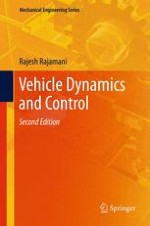2012 | Buch
Über dieses Buch
Vehicle Dynamics and Control provides a comprehensive coverage of vehicle control systems and the dynamic models used in the development of these control systems. The control system applications covered in the book include cruise control, adaptive cruise control, ABS, automated lane keeping, automated highway systems, yaw stability control, engine control, passive, active and semi-active suspensions, tire-road friction coefficient estimation, rollover prevention, and hybrid electric vehicles. In developing the dynamic model for each application, an effort is made to both keep the model simple enough for control system design but at the same time rich enough to capture the essential features of the dynamics. A special effort has been made to explain the several different tire models commonly used in literature and to interpret them physically.
In the second edition of the book, chapters on roll dynamics, rollover prevention and hybrid electric vehicles have been added, and the chapter on electronic stability control has been enhanced.
The use of feedback control systems on automobiles is growing rapidly. This book is intended to serve as a useful resource to researchers who work on the development of such control systems, both in the automotive industry and at universities. The book can also serve as a textbook for a graduate level course on Vehicle Dynamics and Control.
Anzeige
